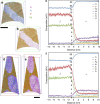A low-cost hierarchical nanostructured beta-titanium alloy with high strength
- PMID: 27034109
- PMCID: PMC4821990
- DOI: 10.1038/ncomms11176
A low-cost hierarchical nanostructured beta-titanium alloy with high strength
Abstract
Lightweighting of automobiles by use of novel low-cost, high strength-to-weight ratio structural materials can reduce the consumption of fossil fuels and in turn CO2 emission. Working towards this goal we achieved high strength in a low cost β-titanium alloy, Ti-1Al-8V-5Fe (Ti185), by hierarchical nanostructure consisting of homogenous distribution of micron-scale and nanoscale α-phase precipitates within the β-phase matrix. The sequence of phase transformation leading to this hierarchical nanostructure is explored using electron microscopy and atom probe tomography. Our results suggest that the high number density of nanoscale α-phase precipitates in the β-phase matrix is due to ω assisted nucleation of α resulting in high tensile strength, greater than any current commercial titanium alloy. Thus hierarchical nanostructured Ti185 serves as an excellent candidate for replacing costlier titanium alloys and other structural alloys for cost-effective lightweighting applications.
Figures





References
-
- DeCicco J., Fung F. (ed). in Global Warming On the Road: The Climate Impact of Americas Automobiles Environmental Defense (2006).
-
- Executive Office of the President, US. Driving Efficiency Cutting Costs for Families at the Pump and Slashing Dependence on Oil Executive Office of the President (2011).
-
- Boyer R. R. & Briggs R. D. The use of beta titanium alloys in the aerospace industry. J. Mater. Eng. Perform. 14, 681–685 (2005).
Publication types
LinkOut - more resources
Full Text Sources
Other Literature Sources

